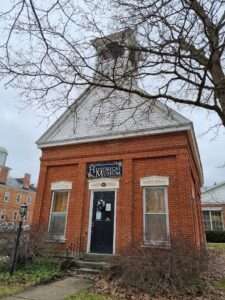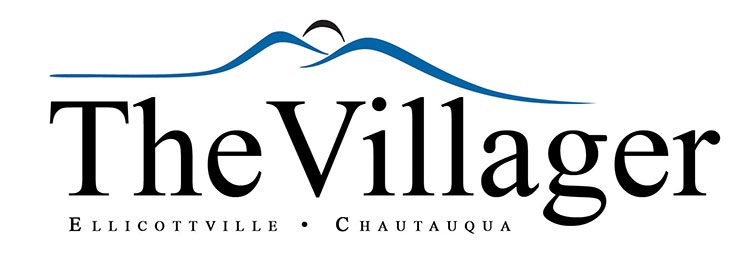Carol Fisher-Linn
Buildings tell us stories…
In 1808 Cattaraugus County was created by the New York State Legislature. A team of several men was sent to find an appropriate location in the county’s center to serve as the county seat. This was all wilderness, heavily wooded, with many small waterways. The area they chose was where several creeks met. I think that today any of us might be hard-pressed to find the ironwood post they drove into the ground, but that post served as the guide for Joseph Ellicott to lay out the town, first establishing the four corners which were intended for public use. Two for county buildings, one for a church and one for a school. Consequently, our four corners in the village of Ellicottville share some of the oldest history in the village.
1

820 saw the rise of the county offices and courts, with a jail being built across the street. The clerk was very busy with the business of this rapidly growing county. So much so that an extra small building for the clerk’s office was built in 1852 behind the county building. This was the birth of the red brick building 172 years ago that would eventually serve as the Ellicottville Historical Museum.
The county seat designation worked well for a time due to its central location and its accessibility to the Chautauqua Road which included the newly established Washington Street. However, the designation was short-lived because it was still rather remote and a day’s ride from anywhere else in the county. In 1868, the railroad laid tracks to Little Valley, bypassing Ellicottville, thus making Little Valley more accessible. As a result, the county seat was moved. The town of Ellicottville bought the county owned buildings and then tore down the jail, reusing the heavy stones from the foundation for the schoolhouse being built across the street on another of the four corners. The clerk’s office was moved into the location previously held by the jail. Thus, Ellicottville began one of several metamorphic changes, moving from a legislative community to an agricultural and industrial community.
Historic documents tell us about the many purposes the little red brick building. One of the first banks in Ellicottville set up shop in the little red building and it then morphed into a Lutheran Church, after which it served as a millinery shop for the ladies. Imagine those ladies in the late 1800’s who were moving away from fuller skirts and bustles, but kept the tight bodices (breathe, ladies, breathe!) and leg-o-mutton sleeves. All that was needed was the perfect hat. And where best to find one than at the milliner in that quaint red brick building on the four corners?
Still later, the building served as a home economics classroom. At that time, before the big school was finished, classes were held in retail business locations, houses and anywhere they could find a room.
With the devastating fire of 1894 that took out the old main county building, the fire department used the little red brick building to store their fire hoses, adding a to rally the firemen. The added a shed to house the pump wagon. They called it the H. F. Northrup Hose Company after H. F. Northrup, who was at that time Village President. Imagine firefighting in those days. Realizing that today’s firefighters in the village are all volunteers, the tradition began way back then in the 1800’s. So, in case of an emergency, the volunteer on call would ring that bell. During school hours, young lads who were given the task would bolt out of the school, run across the street and behind the building to secure the pumper out of its little shed and race to the fire. It is reported that they often got there before the firemen. By 1920 a steam whistle was used to alert fires, with the number of blasts designating in which dis-trict the fire was located. The firemen moved on, and the little red brick building became the Ellicottville library.
When the town hall burned in 1969, the historical society and museum, which had been in the town hall building was without a home. The problem was solved by the library moving into the schoolhouse across the street (1887 Building) and the Historical Society’s museum finding its forever home in the little red brick building on the historic four corners of Ellicottville. The much-loved museum is open June through September on Saturday and Sun-day, 1pm to 4pm staffed by faithful volunteers. A trip to Ellicottville is not complete without a visit to the Museum, or without taking one of their historical walks.
